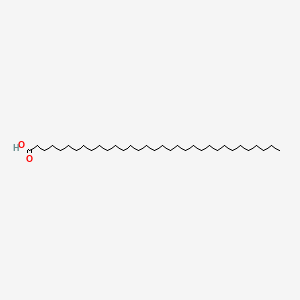| MeSH term | MeSH ID | Detail |
|---|---|---|
| Diabetes Mellitus, Type 2 | D003924 | 87 associated lipids |
| Body Weight | D001835 | 333 associated lipids |
| Hypercholesterolemia | D006937 | 91 associated lipids |
tritriacontanoic acid
tritriacontanoic acid is a lipid of Fatty Acyls (FA) class. Tritriacontanoic acid is associated with abnormalities such as hypercholesterolemia, Metabolic syndrome, Diabetes Mellitus, Non-Insulin-Dependent, Diabetes Mellitus, Insulin-Dependent and Parkinson Disease. The involved functions are known as Fermentation, Process, Longterm Effects, Pressure- physical agent and Lipid Metabolism. Tritriacontanoic acid often locates in Blood, Tissue fiber and A Fibers. The associated genes with tritriacontanoic acid are STN gene. The related lipids are Total cholesterol and blood lipid.
Cross Reference
Introduction
To understand associated biological information of tritriacontanoic acid, we collected biological information of abnormalities, associated pathways, cellular/molecular locations, biological functions, related genes/proteins, lipids and common seen animal/experimental models with organized paragraphs from literatures.
What diseases are associated with tritriacontanoic acid?
tritriacontanoic acid is suspected in hypercholesterolemia, Metabolic syndrome, Diabetes Mellitus, Non-Insulin-Dependent, Diabetes Mellitus, Insulin-Dependent, Parkinson Disease and other diseases in descending order of the highest number of associated sentences.
Related references are mostly published in these journals:
| Disease | Cross reference | Weighted score | Related literature |
|---|
Possible diseases from mapped MeSH terms on references
We collected disease MeSH terms mapped to the references associated with tritriacontanoic acid
PubChem Associated disorders and diseases
What pathways are associated with tritriacontanoic acid
There are no associated biomedical information in the current reference collection.
PubChem Biomolecular Interactions and Pathways
Link to PubChem Biomolecular Interactions and PathwaysWhat cellular locations are associated with tritriacontanoic acid?
Visualization in cellular structure
Associated locations are in red color. Not associated locations are in black.
Related references are published most in these journals:
| Location | Cross reference | Weighted score | Related literatures |
|---|
What functions are associated with tritriacontanoic acid?
Related references are published most in these journals:
| Function | Cross reference | Weighted score | Related literatures |
|---|
What lipids are associated with tritriacontanoic acid?
Related references are published most in these journals:
| Lipid concept | Cross reference | Weighted score | Related literatures |
|---|
What genes are associated with tritriacontanoic acid?
Related references are published most in these journals:
| Gene | Cross reference | Weighted score | Related literatures |
|---|
What common seen animal models are associated with tritriacontanoic acid?
There are no associated biomedical information in the current reference collection.
NCBI Entrez Crosslinks
All references with tritriacontanoic acid
Download all related citations| Authors | Title | Published | Journal | PubMed Link |
|---|---|---|---|---|
| Pare P | The approach to diagnosis and treatment of chronic constipation: suggestions for a general practitioner. | 2011 | Can. J. Gastroenterol. | pmid:22114756 |
| Friedman E et al. | Effects of psyllium fiber and short-chain organic acids derived from fiber breakdown on colonic epithelial cells from high-risk patients. | 1988 | Cancer Lett. | pmid:2849504 |
| Nakamura Y et al. | Psyllium extracts decreased neoplastic phenotypes induced by the Ha-Ras oncogene transfected into a rat liver oval cell line. | 2004 | Cancer Lett. | pmid:14670613 |
| Alabaster O et al. | Potential synergism between wheat bran and psyllium: enhanced inhibition of colon cancer. | 1993 | Cancer Lett. | pmid:8287381 |
| Gharibzahedi SM et al. | Psyllium husk gum: an attractive carbohydrate biopolymer for the production of stable canthaxanthin emulsions. | 2013 | Carbohydr Polym | pmid:23399251 |
| Ladjevardi ZS et al. | Development of a stable low-fat yogurt gel using functionality of psyllium (Plantago ovata Forsk) husk gum. | 2015 | Carbohydr Polym | pmid:25857984 |
| Miraftab M et al. | A new carbohydrate-based wound dressing fibre with superior absorption and antimicrobial potency. | 2014 | Carbohydr Polym | pmid:24299890 |
| Mishra S et al. | Synthesis, characterization and applications of polymethylmethacrylate grafted psyllium as flocculant. | 2014 | Carbohydr Polym | pmid:24274531 |
| Petchetti L et al. | Nutriceuticals in cardiovascular disease: psyllium. | Cardiol Rev | pmid:17438377 | |
| Alarie JP et al. | Psyllium--a gum, not a protein. | 1985 | Chest | pmid:4017692 |
